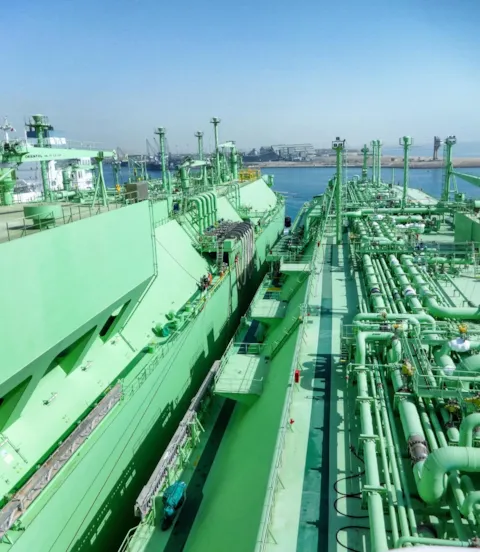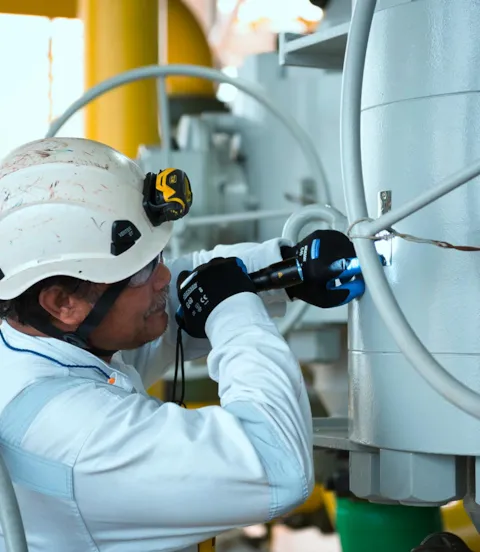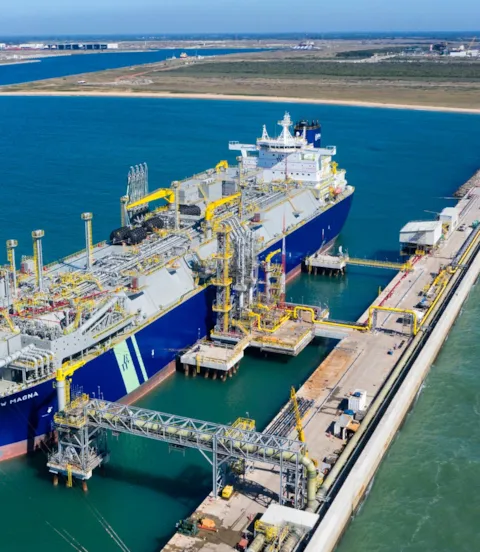Alternative survey programme boosts FSRU availability
DNV has collaborated with key stakeholders to develop an alternative survey regime that keeps stationary floating LNG storage and regasification units (FSRUs) on hire while ensuring that critical safety requirements are met or exceeded.
While LNG transport vessels are exposed to the forces of wind and waves on the open ocean, FSRUs are typically moored in protected areas such as inland waterways or behind breakwaters. Despite the vast differences in their operating profiles, both ship types are currently subject to the same survey regime, including dry-docking and tank entry for inspection every five years.

Rules for stationary FSRUs provide more flexibility
“This is both costly and time-consuming, for both FSRU owners and their customers,” says Pål Einar Spilleth, Ship Type Expert Gas Carriers at DNV. “Quite simply, stakeholders need other rules for stationary FSRU vessels than for seagoing ships.”
In response to this need, DNV has developed an alternative survey programme, or ASP, specifically for stationary FSRUs. Advantages include a more flexible approach with increased on-hire time, and reduced environmental impact. “We have managed to create a relevant rule set to meet stakeholder needs while ensuring the same safety level as conventional tank entry on these specialized vessels,” says Spilleth.

FSRU availability critical to national energy needs
FSRUs are often employed to supply energy to national or regional grids, mandating extreme requirements for uninterrupted production time. “Traditional survey methods involve dry-docking and tank entry, both of which interrupt production,” says Spilleth.
In addition, the units are typically moored in or near port cities, where safety and environmental requirements can complicate standard inspection procedures, including the gas-freeing of tanks in order to allow entry for inspection. “Some cities do not allow gas-freeing in port, and in these cases the unit has to be disconnected from the jetty and taken out into open waters to do gas-freeing , leading to unwanted off-hire time,” Spilleth says.

Shipowners taking initiative for change
“FSRU units are well-suited as fast-track, safe and reliable solutions for meeting countries’ energy needs, but docking the vessel and inspecting the tanks every fifth year is costly and time-consuming, and is based on ships serving in the conventional role of LNG transport,” says Ashok Krishnan, Vice President and Head of Ship Management at BW LNG.
“Countries would probably have to shut off part of their electric grids during the docking procedure. Methane release from ventilating tanks is also an issue. We began to wonder whether we could do this another way,” he relates. “Exemption requires in-principle approval from flag, stating that we are not required to dock these ships. Flag depends on the recommendation of class, and most of our ships are classed with DNV, so it was natural to start a dialogue with them.”
He adds that the industry recognizes the increased risk of damage to tanks that physical entry represents. “We know there are other ways to determine the state of the tank, and not entering is simply safer and with less risk. It is not environmentally friendly to ventilate tanks either, so being able to avoid this is good for everyone.”
FSRU units are well-suited as fast-track, safe and reliable solutions for meeting countries’ energy needs, but docking the vessel and inspecting the tanks every fifth year is costly and time-consuming, and is based on ships serving in the conventional role of LNG transport.

Good cooperation with DNV on ASP notation
“Once the dialogue with DNV was initiated, we received the ASP notation in under 12 months,” Krishnan reports. “There are many steps to be covered, including installation of instrumentation and fatigue analyses. We must provide proof of equal or better safety and security than entering tanks would provide, and the solution must meet the needs of shipowners, as well as flag and class requirements.”
He notes that BW has maintained an open and collaborative dialogue with DNV throughout. “We worked together to find out how we might do things better. It’s always a challenge when you are dealing with an industry first, but DNV is progressive and open to investigating new opportunities.”

Alternative surveys put safety first
In order to determine the alternative survey interval period, DNV has calculated when loads for stationary FSRUs are equivalent to an LNG cargo vessel sailing actively for five years.
Consideration of equipment requiring inspection, like pumps, fittings and other arrangements, is also factored in, and all other surveys are carried out as normal. The integrity of the underwater hull and underwater parts must also be ensured to a standard at least equal to a conventional survey in dry dock.
“We must also be aware of influencing factors when qualifying ships for alternative surveys. Vessel history is a key factor, and conversion vessels must pass a qualifying survey,” says Spilleth. “Location is important, that the vessel is in fact operating from a fixed mooring in a protected environment. The vessel must also remain at a fixed location for the period in between in-water surveys.”
Motion is another factor, with motion sensor systems installed to record and store readings. Weather conditions during the five-year period must also be documented from met-ocean data and factored into the calculations.
Published in 2019, ASP is a dedicated notation for fully compliant units with an extended survey interval for internal cargo tanks, while the ASP Ready notation is intended for ships prepared to enter the programme at later stages. All LNG containment systems are covered, with a particular focus on Moss and membrane tank systems.

Broad cooperation secured on ASP
“We have developed good survey alternatives, but stakeholders have to be open for these, and the clear advantages that they offer,” says Johan Petter Tutturen, Vice President, Business Development, Gas Carriers at DNV – Maritime . “Good multilateral cooperation is required for these solutions to work.”
Within DNV this involved broad cooperation between offshore class, management, advisory services and several relevant disciplines. Externally, cooperation was secured between all major FSRU owners, various FSRU cargo tank designers including both GTT and Moss, equipment suppliers and selected flag states.

Flags on board with ASP
Flag administrations have responded positively to the ASP approach. Among other significant steps, DNV has received principle acceptance from the Norwegian Maritime Authority (NMA) for the applicability of ASP.
“Norway wants to be an attractive flag state operating at the highest safety level. In order to do this we have to be open for innovative solutions, provided they work better for customers and ensure the same or better levels of safety,” says Leiv Andreas Austreid, Director of Cargo Ships and Mobile Units at NMA. “It is important for us to keep our focus on new technology and innovative solutions, and to take a new look at traditional practices.”
The NMA’s main responsibility is to ensure safety when considering new alternatives, Austreid notes. “We have to consider whether there is a legal framework for new solutions. If it can be done within the applicable regulatory framework, we base our position on the technical expertise of class. DNV is a trusted class society, and we refer to their requirements to ensure that structural, equipment and operational integrity are ensured.”

ASP a good future fit for FSRUs
The ASP notation is applicable to existing and future ships, says Tutturen. “There are two new conversions in the pipeline, and more new owners are showing interest, for example in China. LNG is a cleaner alternative to coal, and many countries are looking to reduce or eliminate their coal-fired power production due to environmental concerns. ASP can help them ensure an uninterrupted supply of energy to their grids from FSRUs while ensuring safe and efficient operations.”

Pål Einar Spilleth
Ship Type Expert Gas Carrier
- BW LNG
- DNV – Holger Martens
